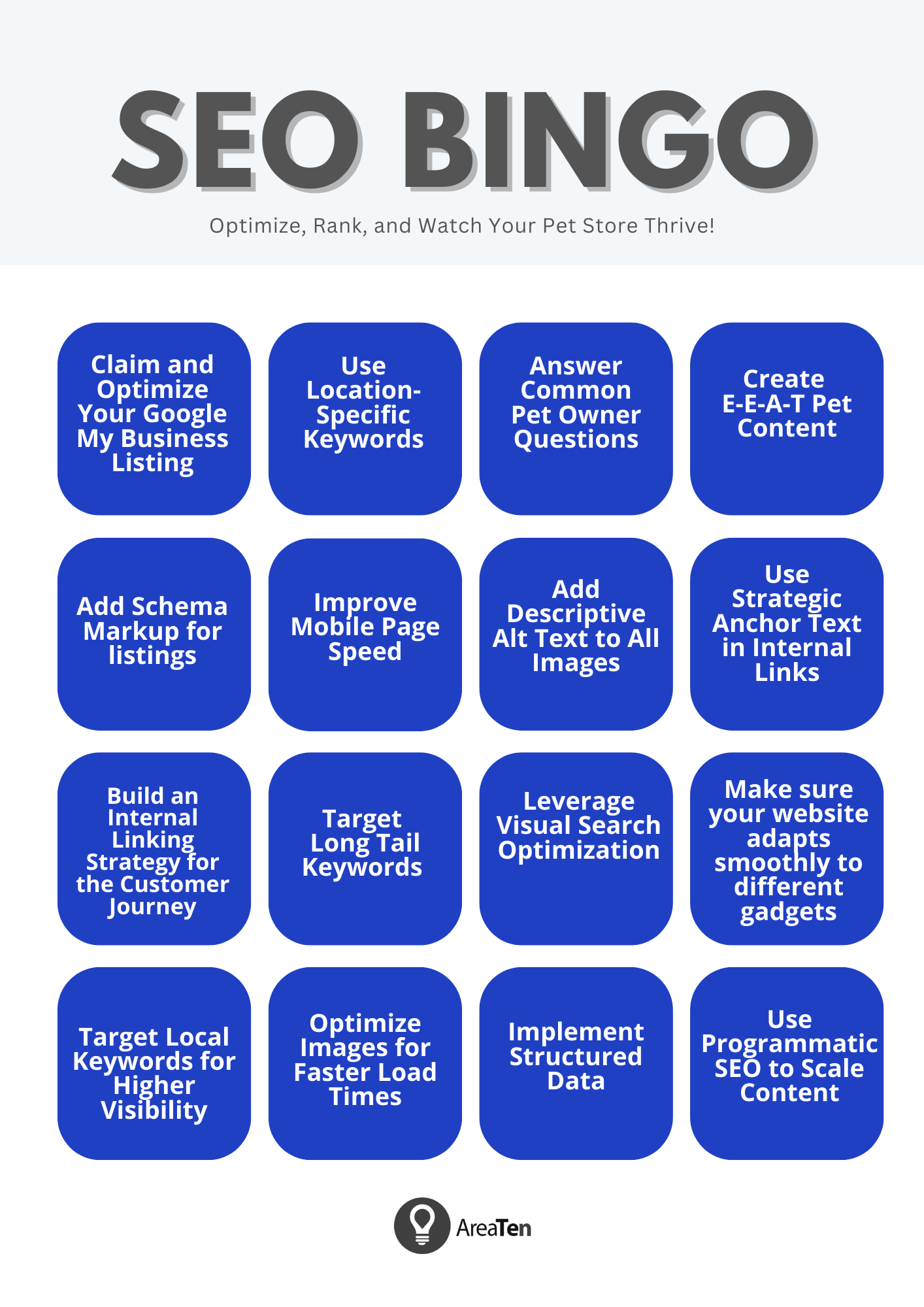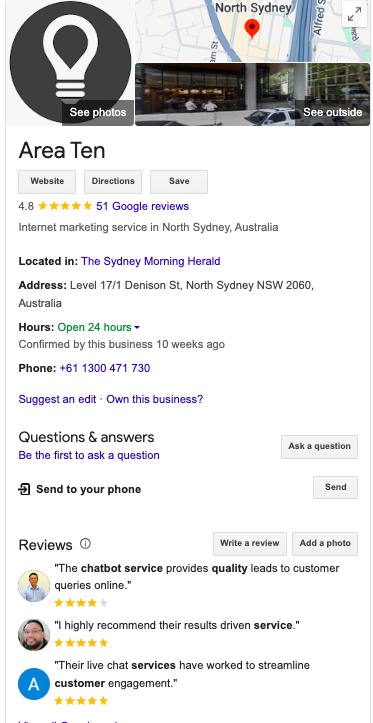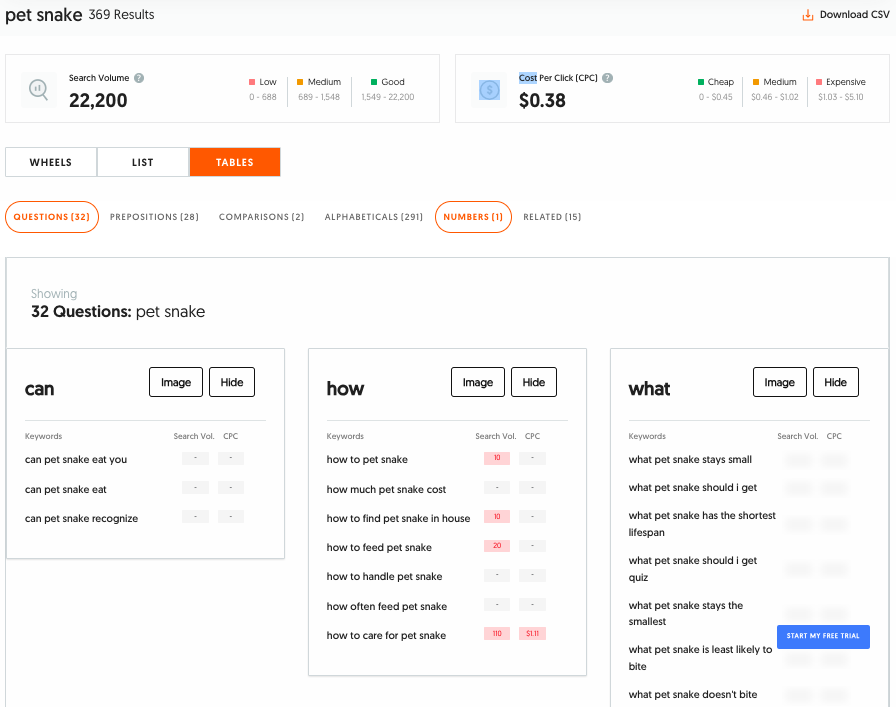7 Underrated Pet Store SEO Tactics You Can Do Now (Can You Hit Bingo?)
by
Jeremy Tang - Updated
01-Oct-2024

Learn 7 effective pet store SEO tactics that will help your business thrive online. By leveraging these strategies, a pet store in Orlando saw huge increases in their organic traffic and sales in just two months.
Having an awesome pet store SEO strategy is a must if you want your pet shop to thrive online and connect with more customers.
Let’s face it: without a solid SEO plan in place, you’re essentially waving goodbye to this huge online audience. But with the right approach, SEO can boost your visibility and position your store as a trusted go-to resource. That means more trust, more loyalty, and ultimately, more customers coming back for those repeat purchases.
Pet owners are spending more time online than ever, and you don’t want to miss out.
If you’re running a pet store, you can’t ignore this fact: 86% of pet owners shop online for their pets (Source: American Kennel Club). What’s more, about half of all pet owners look for advice before they even get their new pet, and two-thirds have already conducted research (Source: National Library of Medicine).
This means that if you’re not leveraging SEO, you’re missing out on a huge chunk of potential customers simply because your store doesn’t show up when they hit “search.” With solid SEO, you can position your store as a go-to resource for people seeking information before getting a pet.
This builds trust and increases your store’s credibility—leading to more traffic and, ultimately, more sales.
Is your pet store’s SEO strategy feeling a little outdated? Maybe your current SEO partner is doing something wildly different from what you see top performers doing online, and it’s just not producing results.
Well, you’re not alone.
Before 2020, an Orlando-based pet store thrived on bustling foot traffic. Locals loved visiting the store to pick up new pets, toys, and supplies, making it a community hub for all things pet-related. However, their website was more of a side project—used primarily by nearby residents for basic information like store hours and directions. The store was so focused on face-to-face sales that their digital presence was barely a blip on the radar.
Then, the pandemic hit.
With COVID-19 lockdowns in full swing, foot traffic disappeared overnight, and online shopping surged across the board. Competitors, some from well outside the Orlando area, quickly pivoted to focus on e-commerce, scooping up business left and right. Even when restrictions eased, the store found that customers weren’t returning at the same pace, and they were losing ground to rivals with robust online strategies.
The wake-up call
The store soon realized that relying on foot traffic alone was no longer sustainable. Their lackluster online presence was becoming a glaring liability. The reality set in: without a significant overhaul of their e-commerce and SEO strategy, their business could continue to decline.
The cost of inaction
Numbers always tell a harsh story. Before the pandemic, the store averaged about 1,500 in-store visitors a month, each bringing in roughly $25 per visit. This translated to around $37,500 in monthly revenue. However, by late 2020, with foot traffic dwindling to just 400 visitors a month, their revenue plunged to only $10,000—a staggering 73% decline.
| Time Period | Monthly Visitors | Revenue per Visitor | Monthly Revenue |
| Before the Pandemic | 1,500 | $25 | $37,500 |
| Late 2020 | 400 | $25 | $10,000 |
At this rate, the store was losing around $27,500 every month just from lost foot traffic alone. They couldn’t afford to continue like this.
A lot of pet stores had this exact same experience. They remain stuck using SEO strategies that worked way back when but just don’t cut it anymore. Search engine algorithms and ranking factors keep evolving, and if your SEO game isn’t keeping up, your profits are going to suffer. When your store’s visibility and traffic are slipping, it’s time to shake things up with better SEO services.
We’re giving you a Bingo card so you can easily check off strategies as you put them into action, ensuring your SEO remains effective and up-to-date.
If you want to print your own copy, you can download the PDF version here: Area Ten Pet Store SEO Bingo Card
As you update your approach and check strategies off your Bingo card, you can rest assured knowing that your pet store SEO strategy is on the right track.
Optimizing for local search ensures your pet store shows up in the right place at the right time—right in front of local customers actively looking for the furry friends and cute critters you have to offer.
The key thing to remember about local customers is that they want convenience. They’re looking for pets close to home, and they want to find the best option without jumping through hoops. That’s where local search optimization comes in.
When you optimize for local search, you’re making sure that when someone nearby is searching for something you offer, your store pops up right in front of them. It’s like waving a flag that says, “Hey, we’ve got your ideal pet right here!” This is key for driving foot traffic and building a loyal local customer base.
Being visible locally means you can outpace local competitors and stay top of mind among your prospective customers in the area.
Mastering your Google My Business (GMB) listing is like setting up a digital storefront for your pet store—it’s the first impression many of your local customers will get.

But here’s the thing: it’s not enough just to claim your GMB listing and fill out the basics. You want to make sure every detail is spot-on.
Essentially, your GMB profile should reflect your store in the best possible light. When you treat it as an extension of your physical shop, you’re setting yourself up for local SEO success
Remember: if someone’s deciding between your pet store and another with incomplete or poorly presented information, your fully optimized profile will be what draws them in.
Search engines love showing results that are relevant to where you are.
If someone types “pet store” into Google, guess what? The search engine will try to prioritize showing stores near that person’s location.
Why? Because proximity matters. And you want your business to be the one that pops up first when someone in your area is looking for what you offer.
That’s where location-specific keywords come into play. Let’s say you’re running a pet store in Chicago. Using keywords like “pet store Chicago” signals to search engines that you’re not just any pet store—you’re the premier local choice.
Getting a pet is a big decision. Your potential customers are essentially looking for a new companion to love and take care of for the long haul, so it’s only natural for them to crave trustworthy content and reliable advice.
Google knows how much this matters too. They’ve put a strong emphasis on E-E-A-T (Experience, Expertise, Authoritativeness, and Trustworthiness), especially in industries like pet care, where bad advice can lead to real harm. If your content doesn’t deliver, it’s not just pet owners who’ll lose faith in you—Google will too, and that could mean lower SEO rankings.
On the flip side, when you constantly put out reliable, expert information, you’re positioning your store as the go-to source for accurate information. And that’s exactly the kind of content that both builds trust and boosts your SEO performance.
So, if you want to grow your store’s online visibility and trust factor, make sure you’re always updating and verifying your content. It’s simple, yes, but definitely effective.
Pet owners love having go-to resources that they can bookmark and come back to later, so creating detailed guides that cover all aspects of pet care is a smart move.
You’ll want to make comprehensive content that addresses everything an owner needs to know about their pet’s entire life cycle, such as:
Highly informative guides like these go a long way in educating your audience and positioning your store as a top authority on pet care, improving customer loyalty in the process. Google recognizes the value of content like this too, so expect your SEO rankings to benefit.
Pet owners always have tons of questions, especially when it comes to caring for their precious pet. Before and after getting a pet, they’re often searching for very specific stuff like “week 6 German Shepherd food” or “feeding schedule for 8-week-old puppies.”
If you can give them clear, well-researched answers that line up with the latest pet care guidelines, your content will be seen as both relevant and authoritative.
Now, you may be wondering, “How do I know what pet owners are asking in the first place?” Fret not—there are tools for that.
One tool in particular that you should consider is AnswerThePublic, which generates a list of the most commonly asked questions based on real search data.
Just type in something like “puppy care” or “reptile feeding,” and you’ll get a list of the top questions people are searching for. Create content around these real-life questions, and you can directly address what pet owners want to know.
Structured data markup can do a lot for your site’s search engine performance.
Think of it like adding little “helper notes” to your website’s code that search engines like Google can easily read. When search engines understand your content better, they’re more likely to show off your store in enhanced search features like rich snippets.
Why is this important? Simple: the more detailed and eye-catching your listing, the more likely someone is to click. It’s like walking past a pet store and seeing all the cute dogs inside wagging their tails, excited to see you. If you’re looking for a new pet, chances are, you’ll want to go in.
Basically, better search engine understanding leads to better visibility and higher click-through rates. So why not make it easier for search engines to do their job?
Schema markup for SEO is a great way to boost your visibility in search results by showing off more detailed info like product listings, reviews, and FAQs. 
It’s a type of structured data that lets Google pull in key details like prices, ratings, and availability right into the search results. Apart from making your listing stand out, it also gives shoppers a heads-up that you’ve got what they’re looking for before they even visit your site. If you’re new to this, you can check out our article on how to use ChatGPT to help you create schema markups efficiently.
Google Merchant Center is an invaluable tool for extending your product reach.
Just upload data for your store and products to Google Merchant Center, and they can appear in Google Shopping and various other Google services, giving you some serious exposure.
The best part? Your products can appear in organic shopping results, so you can reach new customers without paying extra for ads. To really make the most of this, keep your product information accurate and optimized.
You can even highlight promotions and feature customer reviews to make your listings stand out even more.
With so many pet owners shopping from their phones these days, having a mobile-friendly site is a must.
Over 50% of global web traffic now comes from mobile devices (Source: Think with Google), so if your site doesn’t load quickly or display properly, you’re losing a massive chunk of potential customers before they see your products. Whether they’re buying supplies, booking services, or just looking for pet advice, users will quickly move on to a site that gives them a smooth mobile experience.
Your pet store’s website needs to look great and work smoothly, no matter what device your customers are using—whether it’s a phone, tablet, or desktop. Features like pet images, navigation menus, and product details must be user-friendly on all devices, or you risk driving potential customers away.
You see, a mobile-friendly design is a game changer. It helps reduce bounce rates and keeps people on your site longer.
Shoppers can easily scroll through product categories, read up on pet care tips, and make purchases without any hassle. Plus, for those looking to buy a puppy or other pets, having a site that works well on mobile makes it easy for them to view photos, read breed details, and even book an appointment or call you with just a tap.
Google prioritizes page speed as a key ranking factor, especially on mobile, and for good reason.
If your site takes more than a few seconds to load, customers will likely jump ship and head to a competitor with a faster site. To prevent this, it’s important to compress your images and use browser caching to speed things up. Google’s PageSpeed Insights is a handy tool that can point out specific issues slowing down your mobile site, so you can fix them and keep everything running smoothly.
Boosting your mobile page speed not only makes your store attractive to visitors but also aligns with Google’s push toward mobile first indexing, which prioritizes mobile-optimized sites in search results.
With more people using tools like Google Lens to search by images, optimizing your photos can make it easier for pet lovers to find what you have to offer.
Visual search has totally changed how consumers can find pets online—people can now snap a picture to search for anything, from a specific type of fish to the cutest hamster.
To capitalize on this trend, you need to make sure your images are optimized for visual search. That way, when someone snaps a photo, it becomes likely that your pet store’s offerings will pop up in their search results.
Overall, it’s an easy way to connect with more pet enthusiasts and get your products noticed.
Alt text is a simple but powerful tool for both online pet store SEO and accessibility.
When you add alternative text, or alt text, to your images, you’re giving search engines a clear idea of what’s in that image. This, in turn, helps potential customers discover your products through visual search. For example, a photo of a golden retriever puppy should include alt text like “golden retriever puppy” in order to improve both search optimization and user accessibility.
Other than boosting your search rankings, using alt text makes your site a lot more accessible too. This is especially true for users with visual impairments who rely on screen readers to relay alt text to them, describing images in detail.

Source: Venngage
Internal linking has two crucial benefits:
This dual benefit of enhancing both the user’s experience and your SEO performance should not be overlooked. If you want your pet store website to succeed, good internal linking is pretty much mandatory.
Anchor text may just be the clickable part of a link, but choosing the right words can do wonders for your SEO.
When you use keywords in your anchor text, it helps Google figure out what your pages are about, making it easier for people to find your content. For instance, if you have content on “Best Dog Breeds for Families” and another piece on “Puppy Training Tips,” using anchor text like “learn more about training your new puppy here” can effectively link the two.
Mapping the customer journey with smart internal links is all about guiding your website visitors step by step, helping them find exactly what they need while moving them toward a conversion point.
Think of it like setting up a trail of breadcrumbs. When someone lands on your site, they shouldn’t feel lost or unsure about where to go next. Instead, you want to gently nudge them toward the pages that matter.
Start by identifying pieces of content that naturally flow into one another to create an intuitive path.
For example, if your intent is to guide a customer from learning about pets to making a purchase, structure links that progressively lead them down the sales funnel—from “Choosing the Right Pet” to “Top 10 Best Cages for Hamsters,” and finally to “Buy Now” or “Get a Quote” pages.
When done right, smart internal linking can steer user behavior and give your SEO (and your conversions) a serious boost.
Long tail keywords for SEO are highly specific, multi-word search phrases that many businesses overlook.
While they may not bring in a flood of traffic like the head terms everyone’s fighting for, they come with a special bonus: high intent. You see, when people search with long tail keywords, they usually know exactly what they’re after. It’s like someone walking into your store and asking for a particular breed of cat—they’re primed to buy.
Because these terms are so specific, you get less competition for them and a higher likelihood of a search turning into a sale.
Here’s the problem with long tail keywords: there are way too many of them.
There can be thousands of relevant long tail words that you can target, and manually creating SEO content that ranks for each of them sounds exhausting, not to mention expensive. If your competitors aren’t bothering with these nice terms, this is why. But don’t give up—when there’s a will, there’s a way.
Enter programmatic SEO.
Think of it as the ultimate hack, using automation and AI to generate a lot of content efficiently without eating up all your time or budget. With programmatic SEO, you can cover more ground faster, capturing valuable niche traffic that would’ve flown right under your radar if you stuck with manual methods.
Suddenly, reaching those search terms your competitors ignore doesn’t feel so overwhelming, does it?
Remember the pet store that lost thousands every month? Here’s how our digital marketing agency helped them turn things around:
First, we focused on boosting their visibility where it mattered most—locally. We optimized their Google My Business listing, ensuring their NAP and opening hours were all accurate. Implementing good local SEO for pet stores made sure they showed up whenever local customers searched for pets and pet supplies.
Next, we tackled their website.
We needed it to be more than just a place for directions. It had to become a go-to resource for pet owners. So, we started by clearing out the clutter and isolating low-value pages that weren’t doing them any SEO favors. Then, after some solid keyword research, we zeroed in on head terms and long tail keywords that would resonate with their audience.
Then came the content overhaul.
Our copywriters crafted well-researched, high-quality content that addressed pet owners’ most pressing questions, incorporating expert advice from veterinarians and reputable pet care sources. We even included real-life examples, customer testimonials, and detailed guides on pet care to build trust with users.
The goal was to ensure that each page ticked all the boxes for Google’s E-E-A-T guidelines.
This is where things got exciting.
Using CMAX, our proprietary programmatic SEO platform, we created thousands of pieces of fresh content that targeted long tail keywords, like “best place to buy reptiles in Orlando” and “pet store with exotic birds near me.” CMAX also handled automated cross-linking, making the site easier for search engines to crawl and boosting user engagement.
Essentially, it supercharged the store’s ability to capture search traffic without the need for extensive manual content creation.
In just two months, the Orlando-based pet store saw a 35.2% increase in organic traffic and a 42.6% boost in conversions.
By January 2021, their online traffic had surged to 8,000 visitors per month. Given their new conversion rate of 2.5% and an average order value of $30, this led to a monthly online revenue of $6,000.
In-store sales rebounded close to pre-pandemic levels, reaching $35,500 per month. Combining online and in-store sales, the total monthly revenue shot up to $41,500—a net gain of $31,500 compared to their pandemic low.
| Metric | Pre-Pandemic | During Pandemic | Post-Pandemic |
| In-Store Visitors per Month | 1,500 | 400 | 1,420 |
| Average Revenue per In-Store Visitor | $25 | $25 | $25 |
| In-Store Revenue | $37,500 | $10,000 | $35,500 |
| Online Visitors per Month | 1,000 | 1,500 | 8,000 |
| Online Conversion Rate | 0% | 0% | 2.5% |
| Online Orders per Month | 0 | 0 | 200 |
| Average Online Order Value | $0 | $0 | $30 |
| Online Revenue | $0 | $0 | $6,000 |
| Total Monthly Revenue | $37,500 | $10,000 | $41,500 |
Note: The number of post-pandemic in-store visitors is calculated by dividing the in-store revenue by the average revenue per visitor ($35,500 ÷ $25 = 1,420 visitors).
Even after deployment, we continued to refine our keyword strategies for the pet store and CMAX had the ability to adapt with them. This constant fine-tuning meant the store continued to thrive, keeping ahead of the competition and solidifying its place in the market.
At Area Ten, we take SEO, paid media management, and other digital marketing strategies to the next level—perfect for pet store owners who want to stand out online and see quick results.
Say goodbye to the inefficiency of relying solely on traditional methods. Our programmatic SEO technology is designed to get your pet store noticed fast, driving more organic search traffic 4x faster and at 10x the scale. The approaches we use aren’t just geared towards your clicks and rankings either; everything we do is designed to make a positive impact on your business’ bottom line.
Don’t let your competitors take the lead—inquire now about our FREE SEO Fast Track, and watch your traffic and sales soar.
Book a free video consultation below to see how your SEO & Paid Media campaigns are performing against global benchmarks in your industry.
We’ll uncover tangible opportunities to grow your business in just 6 weeks, including: